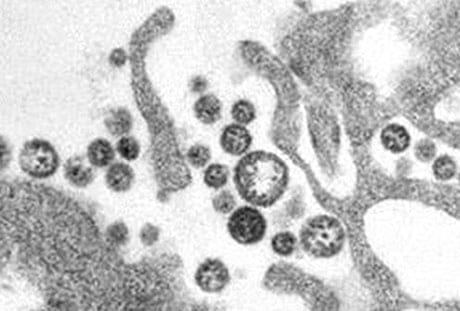Scientists have discovered that the Lassa virus, which is endemic to West Africa, uses an unexpected two-step process to enter cells. The results, published in today’s edition of the journal Science, suggest that the mechanism by which Lassa virus causes infection is more complicated than previously known.
An international team of scientists from the Netherlands Cancer Institute, Harvard Medical School, the University of Kiel in Germany, and the U.S. Army Medical Research Institute of Infectious Diseases (USAMRIID) collaborated on the study, which could lead to new approaches for preventing the disease.
“This research indicates that viruses may require multiple receptors for delivering their viral cargo for productive infection, which is a fresh way of looking at classical viral entry,” said John M. Dye, Jr., Ph.D, of USAMRIID.
According to the authors, it has been known for more than three decades that while Lassa virus can infect a broad range of cells from different species, it does not infect chickens—despite the fact that bird cells have the necessary receptor, or protein, that the virus uses to enter cells. Thus, some additional mechanism appeared to be at work.
Lassa Escapes the Lysosome with LAMP1
Scientists at the Netherlands Cancer Institute and Harvard Medical School discovered that when Lassa virus latches on to its receptor on the cell surface, it is first transported to a structure inside the cell called a lysosome. Lysosomes have been dubbed the “garbage cans” of cells because they break down a variety of molecules. Therefore, in order to infect the cell, Lassa virus needs to escape the lysosome. It does so by hooking onto a protein called LAMP1—a previously undiscovered interior cell receptor for the virus.
“From a virology point of view, this second part of our discovery is the most interesting,” said first author Lucas Jae of the Netherlands Cancer Institute. “The identity of the receptor on the cell surface has been known for 15 years. Nobody expected there to be a second receptor, inside of the cell.”
Research Conducted in BSL-4 Containment Lab
The genetic findings were confirmed by Dye and his team—Andrew Herbert, Ph.D., Ana Kuehne and Ariel Wirchnianski—who demonstrated that mice specially bred to lack the LAMP1 protein were protected from infection with the Lassa virus. This work, performed at USAMRIID using authentic Lassa virus, was critical for validating the role of LAMP1 in Lassa virus infection. Such research can be conducted only in maximum containment Biosafety Level 4, or BSL-4, laboratories, where investigators wear positive-pressure suits and breathe filtered air as they work.
“The discovery of novel intracellular receptors for viruses, like LAMP1 for Lassa virus, opens the door for the development of therapeutics directed against these previously unknown targets,” said Dye.
Lassa virus causes a severe hemorrhagic fever that is 20 to 50 percent fatal in humans, and results in permanent hearing loss in about one-third of those who survive. An estimated 500,000 cases and 100,000 deaths occur each year in West Africa. The disease also affects health care workers in endemic areas, who may lack the necessary equipment to maintain barrier nursing precautions that can keep the disease from spreading.
Funding for the work was provided by the European Research Council (ERC), the National Institutes of Health (NIH), and the Defense Threat Reduction Agency (DTRA).
Read the study at Science: Lassa virus entry requires a trigger-induced receptor switch.
Source: U.S. Army Medical Research Institute of Infectious Diseases, adapted



